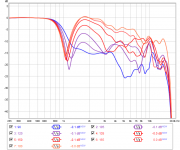Driver is mounted without baffle via steel rod over Linkwitz Pluto type woofer.
Driver measurements are made with REW using loopback timing reference. IR data is exported with windowing and imported to Cool Edit. Kirkeby inverse filters are generated for each driver’s IR. Linear phase BW2 with corner at 35Hz High pass filtering is applied to woofer inverse filter, and 1kHz low pass applied as 1024 point FIR filter. Tweeter inverse is low pass filtered 18kHz with 256 point FIR filter and 1kHz high pass filter applied as 1024 point FIR filter.
Correction filters are saved as stereo pair and used with JRiver Media Player’s convolution engine for playback. Swept sine is played through soundcard in one zone, and recorded to file using another zone. Recordings are made for normal driver polarity and with woofer polarity reversed to check null. Impulse responses are recovered from recordings in Cool Edit, saved, and imported into REW for display.
Measured frequency responses of sealed woofer and TC9FD18 as dipole:
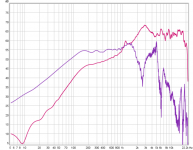
Frequency responses of correction filters:
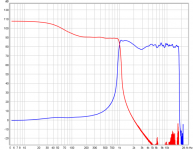
Frequency response overlays of speaker system with correction filters for normal woofer polarity and for reversed woofer polarity:
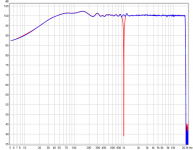
Driver measurements are made with REW using loopback timing reference. IR data is exported with windowing and imported to Cool Edit. Kirkeby inverse filters are generated for each driver’s IR. Linear phase BW2 with corner at 35Hz High pass filtering is applied to woofer inverse filter, and 1kHz low pass applied as 1024 point FIR filter. Tweeter inverse is low pass filtered 18kHz with 256 point FIR filter and 1kHz high pass filter applied as 1024 point FIR filter.
Correction filters are saved as stereo pair and used with JRiver Media Player’s convolution engine for playback. Swept sine is played through soundcard in one zone, and recorded to file using another zone. Recordings are made for normal driver polarity and with woofer polarity reversed to check null. Impulse responses are recovered from recordings in Cool Edit, saved, and imported into REW for display.
Measured frequency responses of sealed woofer and TC9FD18 as dipole:

Frequency responses of correction filters:

Frequency response overlays of speaker system with correction filters for normal woofer polarity and for reversed woofer polarity:

Already been there.
Here are polars for my LXmini clone as implemented with DCX2496:

and:

They outperform Linkwitz design by going from 3" diameter damping chamber to 4":

and:

Here are polars for my LXmini clone as implemented with DCX2496:
and:
They outperform Linkwitz design by going from 3" diameter damping chamber to 4":
and:
Last edited:
No big surprises.
0-90 degrees:
View attachment 487383
90-180 degrees:
View attachment 487384
Lot's of similarities to Linkwitz LXmini.
Thanks for the data.
Here is what I got from the JBL LSR305 waveguide recently.
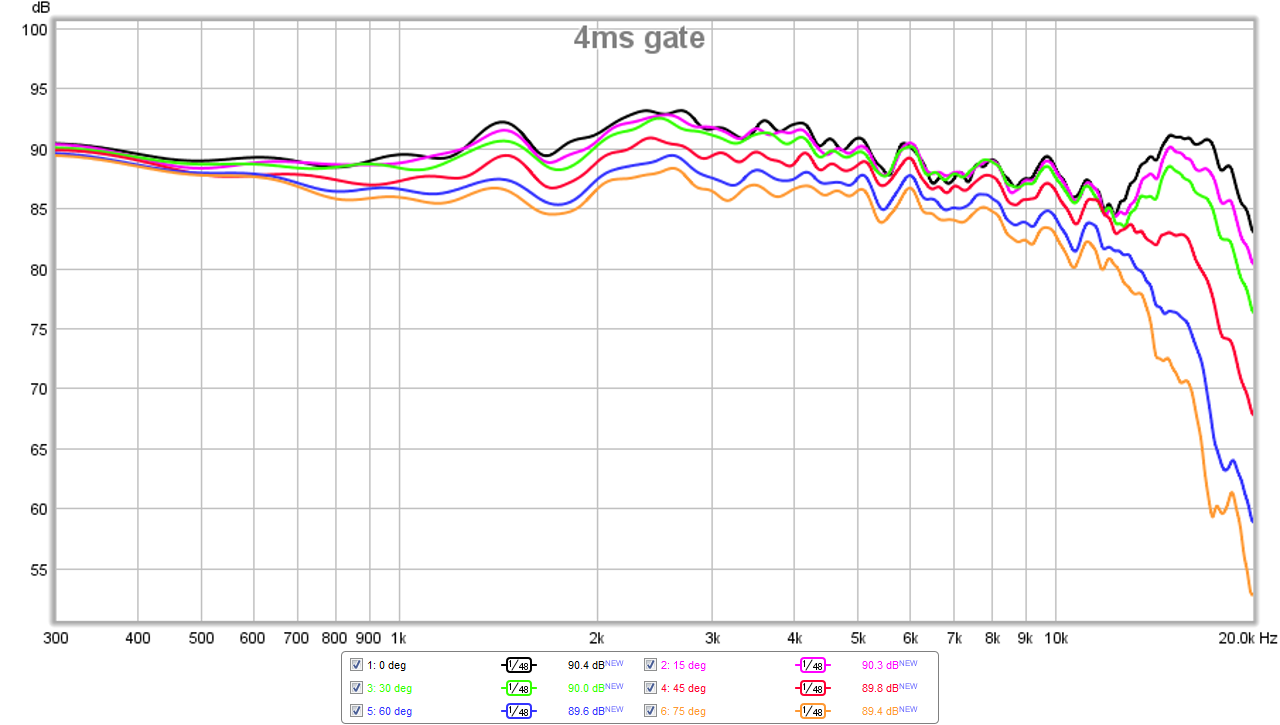
How well does LSR305 measure on vertical axis? With high crossover point the driver centers are >1/4 wavelength apart at XO frequency.
It doesn't seem you were impressed by listening performance. Wide sweet spot, but lost detail?
One of my first tilts at active used North D25-06S tweeter crossed LR8 at 1400Hz. When driven hard it did so with all the classic degradation expected. A master woodworkingfriend built himself a pair and I tuned them:
The super wide, near omni-like radiation pattern leads to nice spectral coherence of reflections(at least in horizontal plane), but in lively listening spaces, as your seems to be, requires fairly close up use to get imaging detail.
It doesn't seem you were impressed by listening performance. Wide sweet spot, but lost detail?
One of my first tilts at active used North D25-06S tweeter crossed LR8 at 1400Hz. When driven hard it did so with all the classic degradation expected. A master woodworkingfriend built himself a pair and I tuned them:
An externally hosted image should be here but it was not working when we last tested it.
The super wide, near omni-like radiation pattern leads to nice spectral coherence of reflections(at least in horizontal plane), but in lively listening spaces, as your seems to be, requires fairly close up use to get imaging detail.
I think you are right, in my reflective room, less dispersion sounds better. That is why my synergies or trynergies sound really nice there. I never bothered to measure vertical Polars.
A combination of omnipolar midwoofer and a dipole tweeter will lead to cardioid response pattern in crossover region. This is a very narrow range with brickwall filters as we can see from polars of the system. Quite drastic changes in power response..?
How this works in a room is the question. Can we have some room response measurements from the listening spot, please? How is the speaker located to walls, what material are the walls?
How this works in a room is the question. Can we have some room response measurements from the listening spot, please? How is the speaker located to walls, what material are the walls?
Your posted link shows an LXmini clone that shows no dipole or cardioid response based on posted polar data:
An externally hosted image should be here but it was not working when we last tested it.
I too based my LXmini clone projects on publicly available information at linkwitzlab.com.
Clearly to me, Charles Denneler was attempting LXmini clone, and when he got his polar data and saw that it looked nothing like LXmini, let his mind call it a cardioid pattern. I see at best in his data a tweeter that rolls off as when placed on narrow baffle. Most likely his windowing choices for measurements are too long, resulting showing more room power response than speaker's polar response. All his room's modal behavior is seen in his results.
My primary interest here was collection of some data prior to setting up for http://www.diyaudio.com/forums/full-range/276349-fast-tc9fd-dsp-performace-testing-platform.html#post4371119 where you re-posted link to Denneler.
Here the link has some relevance; it shows how not to build and measure an LXmini clone. This is useful comparison for others seeking to follow Linkwitz's design. My response to your posting was "All ready been" there, I hoped this was good enough for you to infer that your post is of little value to me.
Why did you re-post link in my FAST thread?
Very cool.
I am interested in full polar plot graph. It would be interesting if you could produce the overall directivity pattern. I assume it would be Omni -> Cardioid -> dipole -> forward directional ?
I am interested in full polar plot graph. It would be interesting if you could produce the overall directivity pattern. I assume it would be Omni -> Cardioid -> dipole -> forward directional ?
gainphile;
Apparently the posted polar plots don't show enough for you?
This one does Omni -> Cardioid -> dipole -> forward directional: http://www.diyaudio.com/forums/multi-way/269936-cardioid-sum-monopole-dipole-speakers.html#post4227362
Cardioid with monopole and dipole source requires overlapping bandwidth of drivers; here with brickwall crossover no realistic cardioid pattern exists.
Apparently the posted polar plots don't show enough for you?
This one does Omni -> Cardioid -> dipole -> forward directional: http://www.diyaudio.com/forums/multi-way/269936-cardioid-sum-monopole-dipole-speakers.html#post4227362
Cardioid with monopole and dipole source requires overlapping bandwidth of drivers; here with brickwall crossover no realistic cardioid pattern exists.
Why did you re-post link in my FAST thread?
Hi, Why not ? It seems relevant, rgds, sreten.
LXmini clone with DCX2496
Barleywater:
Could you share the crossover and EQ settings for DCX2496 LXmini clone?
Thanks
Barleywater:
Could you share the crossover and EQ settings for DCX2496 LXmini clone?
Thanks
- Status
- Not open for further replies.
- Home
- Loudspeakers
- Multi-Way
- TC9FD18 as dipole tweeter crossed at 1kH

